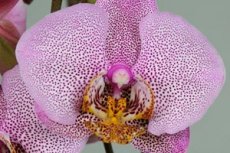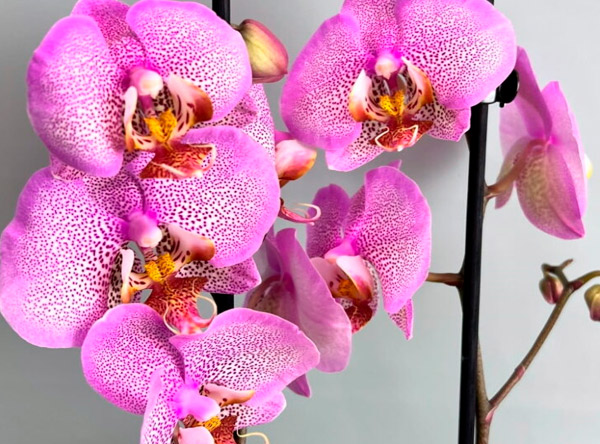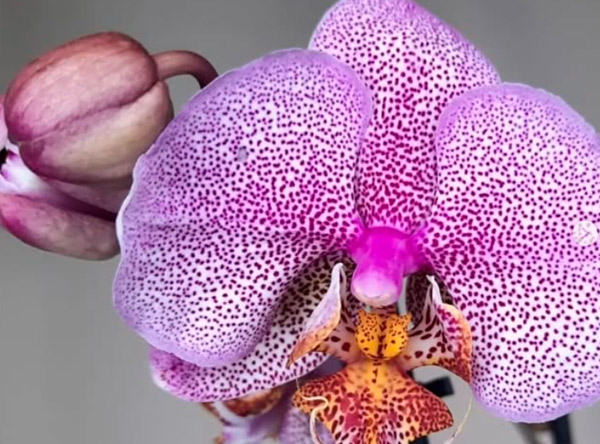Manhattan Orchid
Last reviewed: 29.06.2025

The Manhattan Orchid is a decorative plant from the Orchidaceae family, known for its exquisite flowers with intense hues and unique petal patterns. It is popular due to its long-lasting blooming period and resilience to environmental changes. The flowers have a glossy surface and a dense texture, giving them an attractive appearance.
Etymology of the Name
The name "Manhattan Orchid" comes from the famous New York City district, symbolizing modernity, luxury, and urban elegance. In horticulture, this name emphasizes the flower's vivid and saturated colors, reminiscent of the city's bright lights.
Life Form
The Manhattan Orchid is an epiphytic plant that naturally grows on tree trunks, attaching itself to the bark with aerial roots. These roots absorb moisture from the air, allowing the orchid to thrive without direct contact with the soil.
In indoor settings, the plant is grown in hanging baskets or transparent pots with a light substrate. The roots require good aeration, so specialized potting mixes based on bark are recommended.
Family
The Manhattan Orchid belongs to the Orchidaceae family, which includes more than 25,000 species. This is one of the largest families of flowering plants, distributed worldwide. Orchids can be found in diverse climates, from tropical rainforests to mountainous regions.
Orchids are characterized by their complex flowers evolved to attract specific pollinators. A distinctive feature is the "lip," a modified petal that serves as a landing platform for insects.
Botanical Characteristics
The Manhattan Orchid has long, lance-shaped leaves with a glossy surface. The leaves are a rich green color and range from 20 to 40 cm in length. The aerial roots are covered with velamen, enabling efficient absorption of moisture and nutrients.
The flower stalks are tall and erect, bearing several large flowers measuring 8 to 12 cm in diameter. The petals are thick and often display contrasting stripes or spots. The lip typically stands out with a more saturated hue.

Chemical Composition
The petals contain anthocyanins, providing rich shades from pink to purple. The plant tissues also contain flavonoids, carotenoids, and essential oils that impart a light fragrance. The roots are rich in organic acids and tannins, offering antiseptic properties.
Origin
The Manhattan Orchid originates from tropical regions of Southeast Asia, Central, and South America. The plant thrives in consistently humid environments with stable temperatures.
Its natural habitat includes shady forests with diffused light, abundant moisture from frequent rains, and dense understory. In these conditions, the orchid prospers due to its ability to adapt to humidity fluctuations.
Ease of Cultivation
The Manhattan Orchid is considered moderately challenging to grow at home. The main difficulties include maintaining high humidity and providing adequate light without direct sunlight.
When grown under the right conditions, the orchid adapts well to indoor environments, blooms regularly, and showcases its decorative flowers for several months.
Types and Varieties
Popular varieties of the Manhattan Orchid include:
- Manhattan Purple — intense purple petals with a silvery pattern.
- Manhattan Gold — yellow flowers with bright stripes.
- Manhattan Velvet — velvety petals with a soft pink gradient.
Size
The average height of the Manhattan Orchid ranges from 40 to 80 cm, depending on its age and growing conditions. Flower stalks can reach up to 70 cm, forming large inflorescences.
Individual flowers measure 8 to 12 cm in diameter, with up to 15 buds per inflorescence.
Growth Intensity
The Manhattan Orchid exhibits moderate growth rates. During its active period in spring and summer, it forms new shoots and roots.
In winter, growth slows down, necessitating adjustments in care, such as reduced watering and suspended fertilization.
Lifespan
With proper care, the Manhattan Orchid can live up to 15 years. Regular repotting and substrate renewal contribute to the plant's longevity.
The orchid can bloom several times a year if optimal growing conditions are maintained.
Temperature
The optimal temperature range for the Manhattan Orchid is +18…+25°C during the day and +15…+18°C at night. Temperature fluctuations encourage the development of flower buds.
Sudden temperature changes may cause bud drop or slow growth.
Humidity
The plant requires high humidity levels (60–80%). Use humidifiers, trays with moist expanded clay, or regular misting to maintain adequate moisture.
Lack of humidity can cause root desiccation and leaf spotting.
Lighting and Room Placement
The Manhattan Orchid prefers bright, diffused light. Eastern or western windows are ideal.
In winter, consider using grow lights to extend the daylight period to 12–14 hours. Proper lighting ensures long-lasting and abundant flowering.
Soil and substrate
The Manhattan Orchid requires a lightweight, well-aerated substrate with high moisture retention. The optimal soil mix composition includes:
- 3 parts of coniferous bark (medium fraction) – ensures root aeration.
- 1 part perlite or vermiculite – retains moisture and prevents substrate compaction.
- 1 part peat – maintains a slightly acidic environment.
- A small amount of sphagnum moss – helps retain moisture.
The recommended soil acidity level is pH 5.5–6.5. A drainage layer of expanded clay or pebbles, about 3–5 cm thick, is essential to prevent water stagnation.
Watering
During summer, water the Manhattan Orchid abundantly using the immersion method by soaking the pot in water for 15–20 minutes. Watering is done 1–2 times per week, allowing excess water to drain completely. The substrate should dry slightly between waterings but should not become completely dry.
In winter, reduce watering frequency to once every 10–14 days. Water in the morning so that moisture can evaporate before the evening coolness, preventing root rot.
Fertilization and feeding
During the active growth period (spring to autumn), fertilize the orchid every two weeks using fertilizers with an NPK ratio of 10:20:20 or 4:6:6, promoting root development and flower bud formation.
Apply fertilizers only after preliminary watering to avoid root burns. Feeding is stopped during winter. Organic additives, such as potassium humate or seaweed extract, can be used once a month to boost the plant's immunity.
Propagation
The Manhattan Orchid is propagated through bush division, offshoots, and seeds. Division is carried out in spring by splitting the plant into several parts, each with well-developed roots and pseudobulbs.
Growing from seeds is a lengthy process requiring sterile conditions. Seeds are sown on nutrient agar media in laboratory environments. Full plant development takes several years.
Flowering
The Manhattan Orchid blooms 1–2 times a year, with flowering lasting 2 to 4 months. Buds open gradually, ensuring a long-lasting decorative effect.
For abundant flowering, ensure bright diffused light, regular watering, and fertilization. After blooming, prune the flower stalks to stimulate new shoot formation.

Seasonal care specifics
In spring, the plant enters its active growth phase, forming new shoots and flower buds. During this period, regular feeding and abundant watering are essential.
In winter, the plant enters dormancy, and its growth slows down. Watering should be reduced, and feeding should be stopped. The temperature should be maintained at +12…+15°C to prepare the plant for the next flowering cycle.
Care specifics
Key care requirements include bright diffused light, stable air humidity of 60–80%, and regular watering. Leaves should be wiped regularly with a damp sponge to remove dust.
Avoid moving the plant during flowering to prevent bud drop. Monitoring root health, repotting every 2–3 years, and regular feeding during the growth period are essential.
Repotting
Repotting is done in spring or after flowering, once every 2–3 years. Use transparent plastic pots with drainage holes for light access to the roots.
Replace the entire substrate and remove damaged roots. After repotting, refrain from watering for 3–5 days to allow the roots to heal.
Pruning and crown shaping
After flowering, remove dried flower stalks and dead leaves. Use sterile tools for pruning, and sprinkle the cuts with crushed charcoal.
Potential problems and solutions
Common problems include root rot due to overwatering, bud drop from insufficient light or drafts, and leaf spots from cold damage.
Correct growing conditions, treating plants with fungicides for fungal infections, and ensuring optimal temperature and lighting are recommended.
Pests
Common pests include spider mites, scale insects, aphids, and mealybugs. At the first sign of infestation, treat the plant with insecticides.
Air purification
The Manhattan Orchid actively absorbs carbon dioxide and releases oxygen. Its leaves capture dust and toxins, improving indoor air quality.
Safety
The plant is safe for children and pets, as it does not contain toxic substances. However, people prone to pollen allergies should avoid direct contact with its leaves.
Wintering
In winter, maintain a temperature of +12…+15°C, reduce watering, and stop feeding. Gradually resume active care as spring approaches.
Beneficial properties
The Manhattan Orchid possesses antioxidant and antiseptic properties due to its organic acids and essential oils.
Use in landscape design
The plant is ideal for decorating winter gardens, greenhouses, and hanging compositions, thanks to its spectacular flowers.
Compatibility with other plants
The Manhattan Orchid pairs well with ferns, anthuriums, and other decorative plants, creating harmonious tropical compositions.
Conclusion
The Manhattan Orchid is an extraordinary plant with exquisite flowers that demands attention and proper care. Following recommended growing conditions ensures long-lasting enjoyment of its beauty.
